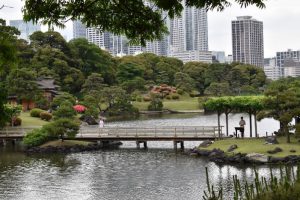Hama-rikyu is a public garden located on the shore of Tokyo Bay in the Shiodome District in Central Tokyo. It is a massive complex, with saltwater ponds that rise and fall with the tides of Tokyo Bay. Various paths and bridges snake around the garden and hills that allow people to experience different perspectives of the scenery. It is a convenient place to go to for seeing greenery in Tokyo, the world’s largest metropolitan area.

The garden’s history began in 1654, when a member of the Tokugawa family (the dynasty which ruled Japan through the shogunate during the Edo Period) built the first parts. The area was eventually taken over by the Shogunate in 1709 by the 6th Tokugawa Shogun, Tokugawa Ienobu. Successive Tokugawa Shoguns would continue to add to the garden and use it as a second palace. It was during this time that the ponds were used for duck hunting. At the time, the garden could be used to view several landmarks such as Tokyo Bay, Edo Castle, and Mount Fuji. Several tea houses were also constructed for entertainment of the shogun and his guests. At one point, a male elephant that had been purchased from Vietnam was kept in Hama-rikyu.

The Tokugawa Shogunate, however, ended amidst civil strife caused by the opening of Japan by Western colonizers. The Meiji Restoration in 1868 replaced the Shogunate with a government headed by Emperor Meiji and his descendants. Among the properties that were seized from the Tokugawa family and given to the imperial household was Hama-rikyu. Emperor Meiji would continue to use the garden as a place to stay and entertain foreign guests. One such foreign dignitary that Emperor Meiji met with was former US President Ulysses Grant in 1879.


The latter half of the Imperial ownership of Hama-rikyu was hit with a myriad of disasters. The Great Kanto Earthquake in 1923 along with fire bombings in World War II destroyed or burnt down all but one of the teahouses. With the end of World War II, the imperial household gave away many of the properties it owned, one of which was Hama-rikyu that was gifted to the city of Tokyo. In 1946 the garden was opened to the public and has been ever since.

A part of what makes Hama-rikyu unique is its saltwater ponds. The ponds are connected to Tokyo bay, with locks and gates used to keep parts full with the rise and fall of the tides. Some parts, however, will drain and fill depending on the tide. This means that the scenery of the pond is subject to change. Saltwater fish and eels even make the ponds their home. On the largest pond, bridges run across the pond. Their purpose is not just to cross the pond, but also to give people a different perspective of the water and land. The bridges also lead to small islands, one of which has a teahouse. At one of these teahouses, the Hobaitei, you can even reserve a spot for a teas ceremony. The bridges are made of Japanese cypress, which is a traditional construction material.


The layout of the garden, with small hills called yama (mountains) and small pond island ponds called shima (island), is meant to model the Earth. This way of miniaturizing the world with a garden is not unique to Hama-rikyu. Japanese gardens often do this in different variations. Japanese Zen gardens use sand and rocks to represent water and land in the same way that Hama-rikyu uses its rolling hills and ponds.
Varieties of flowers and trees are dispersed throughout the garden. Depending on what time of year that you go, you could can see different plants in bloom. The trees come in all shapes and sizes. One black pine was planted in 1709 by Tokugawa Ienobu. The picture to the right doesn’t quite capture its magnificence.

The backdrop of urban Tokyo skyscrapers never escapes your view in Hama-rikyu. I think this is what makes the garden especially unique. It is a product from three hundred years ago sitting in the middle of a modern metropolis. The contrast between the rolling hills and ponds that common people and emperors alike have been enjoying for hundreds of years, with the monuments to modern society in the background exemplifies much of what makes Japan, Japan. Overall, Hama-rikyu is an amazing place to reset your mind while in Tokyo, while appreciating the uniqueness of the city.







